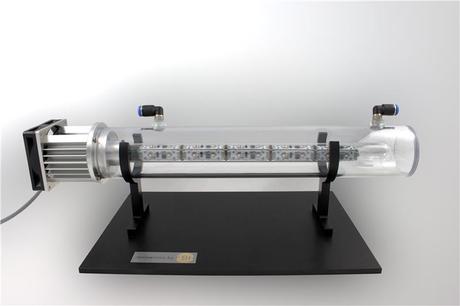LEDs and diode lasers on display

Germany’s Ferdinand-Braun-Institut (FBH) has announced novel developments and advancements in its diode lasers and UV light-emitting diodes (LEDs). The institute’s products will be showcased at the international micro photonics fair, to be hosted in Berlin from 11–13 October.
Diode laser modules with optical fibre connection
The FBH offers compact diode laser modules that allow customers to utilise high-brilliance laser radiation in their applications. Due to an integrated singlemode fibre (SMF) port, the matchbox-sized modules can be easily installed into different systems. This way, efficient laser light sources are available for the near-infrared spectral range, delivering diffraction-limited radiation with narrow bandwidth exactly where it is needed.
Tailored light impulse source
The institute has also developed the PLS 1030 — an efficient pulsed laser source which is currently being optimised to have all functionalities integrated in one compact device. The all-in-one product delivers ultrashort light impulses at a wavelength of 1030 nm within an adjustable time range from 5 to 15 ps and provides freely selectable repetition frequencies, from the hertz to the megahertz range. The computer-operated laser source can be easily integrated into various laser systems, thus ensuring stable and user-friendly operation.
High brilliance and output powers for diode lasers and bars
The institute develops highly brilliant diode lasers in a wide variety of designs and packages, covering the wavelength range from 630 to 1180 nm. Single emitters with a stripe width of 90 µm, for example, reach peak brilliance results with 3.5 W/mm-mrad. In addition, smaller stripe widths deliver up to >6 W/mm-mrad. For materials processing applications the FBH has developed custom arrays for spectral beam combining, consisting of five brilliant DFB lasers with 30 µm apertures, each yielding 5 W output power with 50% efficiency in a brilliant beam. The emitter-to-emitter wavelength spacing is 2.5 nm.
Module for water disinfection
Finally, FBH has designed a rod-shaped module for water disinfection purposes using 262 nm LEDs. This module aims at replacing conventional low-pressure mercury vapour lamps, as the UV LEDs have higher lifetimes, are maintenance-free and do not require toxic chemicals. Wavelength and emission characteristics can also be adjusted specifically to the desired application. The FBH set-up is modularly expandable and can thus be adapted to various reactor sizes.
The exhibits will be on display at the micro photonics fair in Hall 7.2C, Booth 207. For more information on the event, visit http://www.micro-photonics.de/en/.
Organic transistor 'limitation' improves stability
Researchers have shown that a longstanding organic transistor design limitation actually improves...
OLED circular polarisation is now electrically switchable
Researchers have discovered a way to control left- or right-handed polarised light via charge...
Nanoscale pixels to advance augmented reality eyewear
Physicists have developed extremely small pixels that can be used in compact AR glasses, using...




